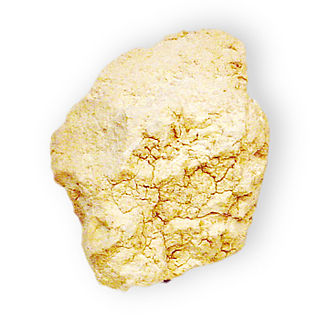Hectorite
Phyllosilicate clay mineral From Wikipedia, the free encyclopedia
Hectorite is a rare soft, greasy, white clay mineral with a chemical formula of Na0.3(Mg,Li)3Si4O10(OH)2.[2]
| Hectorite | |
|---|---|
 Hectorite from California | |
| General | |
| Category | Phyllosilicates Smectite |
| Formula | Na0.3(Mg,Li)3Si4O10(OH)2 (empirical: Na3(Mg,Li)30Si40O100(OH)20) |
| IMA symbol | Htr[1] |
| Strunz classification | 9.EC.45 |
| Crystal system | Monoclinic |
| Crystal class | Prismatic (2/m) (same H-M symbol) |
| Space group | C2/m |
| Unit cell | a = 5.25 Å, b = 9.18 Å c = 16 Å; β = 99°; Z = 2 |
| Identification | |
| Color | White, cream, pale brown, mottled |
| Crystal habit | Thin laths and aggregates |
| Cleavage | [001] Perfect |
| Fracture | Uneven |
| Mohs scale hardness | 1–2 |
| Luster | Earthy to waxy |
| Streak | White |
| Diaphaneity | Translucent to opaque |
| Specific gravity | 2–3 |
| Optical properties | Biaxial (−) – 2V small |
| Refractive index | nα = 1.490 nβ = 1.500 nγ = 1.520 |
| Birefringence | δ = 0.030 |
| References | [2][3][4] |
Hectorite was first described in 1941 and named for an occurrence in the United States near Hector, California (in San Bernardino County, California,[4] 30 miles east of Barstow.) Hectorite occurs with bentonite as an alteration product of clinoptilolite from volcanic ash and tuff with a high glass content.[2] Hectorite is also found in the beige/brown clay ghassoul, mined in the Atlas Mountains in Morocco.[5] A large deposit of hectorite is also found at the Thacker Pass lithium deposit, located within the McDermitt Caldera in Nevada. The Thacker Pass lithium deposit could be a significant source of lithium.[6]
Despite its rarity, it is economically viable as the Hector mine sits over a large deposit of the mineral. Hectorite is mostly used in making cosmetics, but has uses in chemical and other industrial applications, and is a mineral source for refined lithium metal.[7]
See also
- Classification of minerals
- List of minerals
- Saponite – Trioctahedral phyllosilicate mineral
References
Wikiwand - on
Seamless Wikipedia browsing. On steroids.
